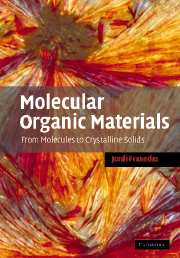Book contents
- Frontmatter
- Contents
- Preface
- List of abbreviations and symbols
- List of chemical abbreviations
- 1 An introduction to molecular organic materials
- 2 Building molecules: molecular engineering
- 3 Building materials: crystal engineering
- 4 Interfaces
- 5 Thin-film growth: from 2D to 3D character
- 6 A miscellany of physical properties
- Afterword
- Appendix A
- Appendix B
- References
- Index
5 - Thin-film growth: from 2D to 3D character
Published online by Cambridge University Press: 23 November 2009
- Frontmatter
- Contents
- Preface
- List of abbreviations and symbols
- List of chemical abbreviations
- 1 An introduction to molecular organic materials
- 2 Building molecules: molecular engineering
- 3 Building materials: crystal engineering
- 4 Interfaces
- 5 Thin-film growth: from 2D to 3D character
- 6 A miscellany of physical properties
- Afterword
- Appendix A
- Appendix B
- References
- Index
Summary
My growth is not your business, Sir!
Lewis Carroll, Size and TearsAs soon as the number of MLs increases, or equivalently, when we leave the realm of 2D heterostructures and enter our more familiar 3D space, the deposited materials tend to recover their intrinsic bulk properties, as already discussed in the previous chapter for CuPc, reducing the influence of the interface. For these increasingly thicker deposits the morphology becomes a relevant issue because films generally exhibit physical boundaries (steps, grains, etc.), so relevant that sometimes the physical properties of the films depend mostly on the particular morphology, rather than on their intrinsic properties. Some examples on this significant point will be given in Section 6.4. In fact, long-range ordered films as well as single crystals become thermodynamically stable only in the presence of perturbations such as defects and boundaries. The surface morphology depends not only on the nature of the intermolecular interactions but also on the selected experimental conditions. This situation is crucial. Depending on the chosen points or trajectories in the parameter hyperspace the morphology may substantially vary. Hence, when exploring the growth for a particular system the actual experimental conditions have to be described as accurately as possible.
The present chapter is devoted to several aspects of the growth of thin films of MOMs, such as growth modes, micrometre- and nanometre-scale morpohologies, control of orientation, polymorphism, etc., without pretending to be a classical canonical treatise of crystal growth.
- Type
- Chapter
- Information
- Molecular Organic MaterialsFrom Molecules to Crystalline Solids, pp. 207 - 241Publisher: Cambridge University PressPrint publication year: 2006

